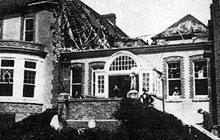World War 2
Introduction
Hastings suffered 85 visits from the Luftwaffe from the first air raid on 26th July 1940 to the end of the war in 1945. During this time 550 HE bombs and 16 flying bombs or "doodlebugs" fell on the town, causing the loss of 154 lives. 260 people received serious injuries and 439 lesser injuries. There were also 12 oil incendary bombs and 750 small incendary bombs.
There was widespread damage to houses in the town, with 463 houses being damaged beyond saving or completely demolished. 14,818 other properties also received damage but were salvagable. A considerable number of bombs also fell in the sea and caused no damage.
Voluntary Evacuation
The second round of voluntary evacuations saw the saw the population of Hastings almost halved overnight from 65,000 to 34,000, and took place on the 11th September 1940. As the bombing had already started it was more of a mass exodus. 14,000 residents left by special trains and 5,000 by special railway coaches. Thousands more left the area too but preferred to make their own arrangements with relatives or friends living in safer places.
The number of casualties was much lower than expected during the following months as many houses were uninhabited, however lives were still lost and many homes and businesses were destroyed. Damaged buildings included both the Royal East Sussex Hospital (RESH) and St Helens Hospital.
Defences
Hastings had no anti-aircraft guns until 14th October 1940 so was left completely at the mercy of German planes that were free to circle the town dropping their bombs and then heading back across the channel. Anti-aircraft guns were installed around the town and heavy guns on the West Hill as a defence against flying bombs (V1’s) but the scale of the attacks often made defence impossible.
St Clements Caves
The caves formed a natural air-raid shelter for many Old Town families when bombing began in 1940. The caves were kitted out with 500 bunk beds and a new entrance was knocked through into Croft Road. The people ate, slept and generally lived as an underground community. A fully equipped medical centre, sick bay and dining hall were also added and an official inspector from the Civil Defence Commissioner remarked that it was "the best air-raid shelter in the country".
Rationing
Clothes rationing began on Whit Sunday (June 1st) in 1941. 66 coupons were given to every citizen and some had to be used ever time an article of clothing was purchased. The allowance of coupons was reduced in following years as the war went on.
War Weapons Week
This was heald from 10th to 17th May 1941 in order to raise money to loan the government in the form of War Savings. The target was £200,000 and this was easily met despite the towns' much reduced population. Locals raised a total of £370,940 for the cause, which was shown on an indicator panel designed by students of the Hastings School of Art. The panel was attached to the Albert Memorial Clock Tower in the Town Centre.


